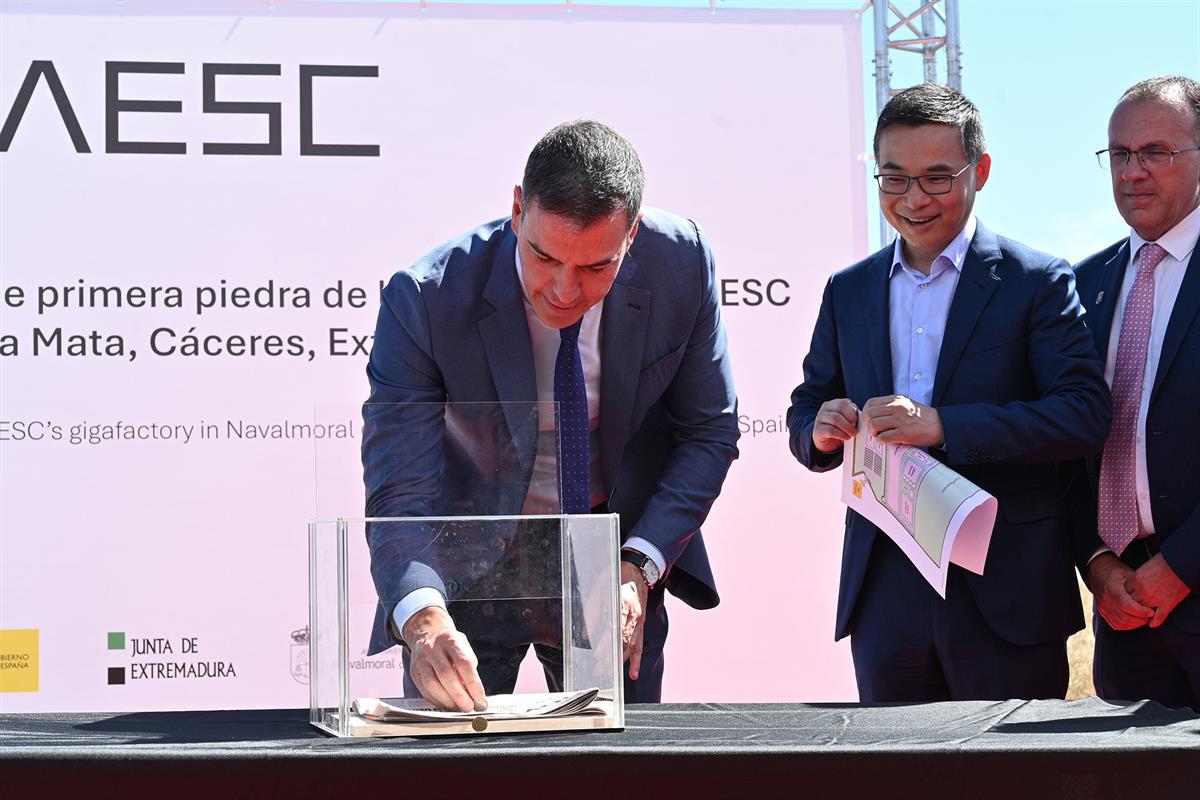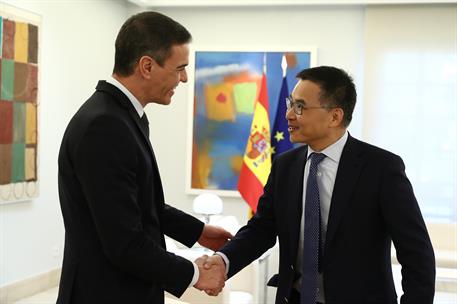Pedro Sánchez: AESC's gigafactory is the "best example" of green and digital reindustrialisation and foreign investment
President's News - 2024.7.8
Images of the event of laying the cornerstone of the AESC gigafactory | Pool Moncloa/Carlos Herrero - 2024.7.8
Navalmoral de la Mata (Cáceres)
Pedro Sánchez stressed that the project is the "best example" of the Executive's commitment to reindustrialising Spain in a green and digital way and that it will help to position Extremadura as "an international benchmark in the automotive industry of the future".
This is what he said during his speech at the closing ceremony, which was attended by the Minister for Industry and Tourism, Jordi Hereu; the President of the Regional Government of Extremadura, María Guardiola; the CEO of AESC, Lei Zhang; the CEO of AESC Europe and USA, Knudt Flor; the Mayor of Navalmoral, Enrique Hueso, and the Government Delegate in Extremadura, José Luis Quintana.
Pedro Sánchez considers that the gigafactory initiative is evidence of the Government's commitment to attracting foreign investment and to sectors that guarantee "stable, dignified and quality employment", as well as the confidence that Spain inspires, leading growth among the major European economies in a difficult geopolitical context and creating four out of every ten new jobs in the European Union. In this way, he stressed that the project is a good example of the "best policy, which generates quality jobs, transforms a territory and offers it a future full of opportunities", thanks to the commitment to ecological transition and the union and agreement between all public administrations, together with public-private partnership.
The project, which will have an investment of 1 billion euros in its first phase and will create 900 jobs in this initial stage, will help to position Extremadura as a "benchmark in cutting-edge technology". This is a "victory against relocation and against industrial decline", emphasised Pedro Sánchez, who thanked AESC for its work in bringing forward an initiative that "will bring progress, wealth and employment" to the region, after recalling the legal reforms implemented to undertake the industrial initiative, such as Land and Urban Planning, the Law on Administrative Simplification and Rationalisation and the new regulation on the lithium and green hydrogen value chain.
Spain, a powerhouse in the automotive sector
 The President of the Government of Spain, Pedro Sánchez, places commemorative objects inside an urn, at the ceremony of laying the cornerstone of the AESC gigafactory | Pool Moncloa/Borja Puig de la Bellacasa
The President of the Government of Spain, Pedro Sánchez, places commemorative objects inside an urn, at the ceremony of laying the cornerstone of the AESC gigafactory | Pool Moncloa/Borja Puig de la Bellacasa
The head of the Executive stressed that "our country is a great power in the automotive sector", as it is the second largest producer in Europe and the eighth largest exporter in the world. In this respect, he pointed out that Spain has 17 automotive factories in 10 autonomous communities, 15 technology centres and 10 automotive clusters. In fact, in 2023 alone, the Spanish automotive sector exceeded 44 billion euros in exports.
The new project will give greater impetus to these figures, said Pedro Sánchez, confirming the "country's commitment" to sustainable mobility as an "extraordinary opportunity for development". The Government has allocated more than 5 billion euros in successive calls for proposals for the PERTE for electric and connected vehicles with a capacity to mobilise resources worth almost 24 billion euros in total investment. In fact, the Ministry of Industry and Tourism has just launched two new calls for aid for electric vehicle production initiatives and will continue with the launch of PERTE VEC IV, with a budget of 1.25 billion euros.
"Today is a great day for the present and future of Extremadura"
The President of the Government of Spain, Pedro Sánchez, closes the ceremony to lay the cornerstone of the AESC gigafactory in Navalmoral de la Mata (Cáceres) | Pool Moncloa/Borja Puig de la Bellacasa
Similarly, Pedro Sánchez stressed that the factory represents the realisation of a "crucial objective" of the Government of Spain, which is to advance in the reindustrialisation of the productive fabric and a clear example of the commitment to a cutting-edge industrial sector. For this reason, he pointed out that the commitment to investment in human capital will be redoubled. Thanks to the Recovery Plan, more than 6,000 new vocational training places have been created in Extremadura alone. Of these, 257 correspond to three educational centres in Navalmoral de la Mata, almost 40% linked to areas such as electrical and automated systems, electric vehicle batteries, Artificial Intelligence, Big Data, microcomputing and networks.
"Today is a great day for the present and future of Extremadura", Pedro Sánchez celebrated after praising the "decisive commitment" of the former president of Extremadura, Guillermo Fernández Vara, in bringing the initiative forward. Furthermore, Pedro Sánchez indicated that the Government is putting territorial cohesion "in the place it deserves in order to better structure our country and provide opportunities". In this sense, Extremadura accounts for 14% of the total aid granted in the PERTE VEC, seven times more than what would correspond to its demographic weight. These resources are being supported by "super exciting" projects such as Lithium Iberia and Extremadura Lithium Technology, with more than 32 million euros in subsidies for the production of Lithium Hydroxide, the development of the Iberian Energy Storage R&D Centre in Cáceres, or the Gamma Solutions project.
The president of the Government of Spain predicted that the new plant in Navalmoral will have "a decisive impact on the traction of more companies in the sector" and will be "the first stone in the generation of an entire ecosystem around the electric vehicle value chain". "Extremadura is going to become something unimaginable just a few years ago: an international benchmark in the automotive industry of the future", he predicted.
Non official translation






